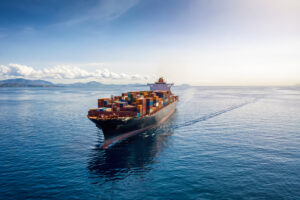
Freight rates surge as shipping feels ‘whipsaw’ event with tariff changes
By onAnnouncements | International | Market Trends
Freight rates and cargo space are experiencing a “whipsaw” event due to tariffs, similar to what was seen at the start of the COVID-19 pandemic, according to a shipping news update from Steve Hughes, HCS International president and CEO.
“Similar to the COVID experience, when the president initially announced the tariffs, a very large number of companies nationwide and across industries issued stop orders to their overseas factories,” Hughes wrote in the update. “This effectively halted a significant portion of ocean shipping. The ocean carriers, seeing their ships being underutilized, started blanking sailings or suspending lanes. This can result in either skipping a scheduled sailing or cancelling sailings until further notice.”
Hughes says that upon the pause of tariffs by President Donald Trump, companies promptly released holds they had placed on their orders.
“This sudden release triggered an overwhelming rush of cargo to the ports, catching ocean carriers off guard,” Hughes says. “In response, carriers have scrambled to bring ships back online to manage this unexpected surge in demand. However, the imbalance between demand and available space has led to sharp fluctuations in spot rates.”
Spot rates for shipments from Asia to the U.S. increased on June 1 for major container lines, according to Hughes. This includes rates poised to rise to $6,000 per 40-foot equivalent unit (FEU) for shipments to the West Coast and $7,000 per FEU to the East Coast.
“Alarmingly, projections for July 1 indicate potential further increases of up to $2,000, further compounding the challenges faced by shippers,” Hughes says.
Hughes says the Trans-Pacific capacity is expected to rebound swiftly. He said this includes all carriers deploying additional ships over the next three weeks.
“This adjustment should alleviate some pressure,” Hughes said. “However, shippers should remain cautious as the market adapts to these rapid changes and uncertainties persist.”
The current market should “brace itself for continued unpredictability,” according to Hughes.
Congestion at ports will likely start in mid- to late July, he says.
In other shipping news, the Houthis’ attack on international shipping and Israel is showing some signs of weakening.
Hughes says this is due to the Trump Administration designating the Houthi group a terrorist group, shutting down their channels of funding, and using a military push to eliminate Houthi threats.
This could lead to shipping returning to the Red Sea and Suez Canal, Hughes said.
If shipping returns to the canal, it could cause significant congestion at all associated ports for months, he says.
“Once stability returns to the region, carriers will start to consider going back to the Suez Canal and peel off from this long line going around the Cape of Good Hope to eliminate the two-plus weeks of transit time and the associated costs,” Hughes writes. “When this happens, instead of one scheduled line of ships arriving at the various ports, you will have a second line of arrivals that is in effect showing up two plus weeks early.”
Hughes says that at the end of congestion, there could be an overhang of space available, due to the increase in container ships in 2024 and this year, to handle the closing of the canal.
In 2024, there were more than 350 new container ships, Hughes said. He said another 200 are expected this year.
Hughes says that another issue to watch is the Indirect Source Rule (ISR), also known as the Ports Infrastructure Rule, brought forth by the South Coast Air Quality Management District (AQMD).
“Future cargo caps and additional mandates may be imposed,” Hughes said of the rule. “Increased government bureaucracy and associated costs are anticipated. And, it’s important to note that even though this may seem to be a regional issue, if implemented, it will have wide-ranging impacts across our industry.”
Hughes also pointed to two S&B Journal of Commerce articles that he says are important reads for anyone shipping through Shanghai, Singapore, Port Klang, or India.
The publication says Singapore and Shanghai, the world’s second-busiest and busiest ports, are facing congestion due to a rush of exports to the U.S. during a 90-day tariff cooldown. The congestion has disrupted transshipment cargo, delaying it by up to two weeks.
Congestion will spread to the U.S. West Coast ports next month as the ships start arriving in Los Angeles and Long Beach, according to the publication.
“Similar to during the pandemic, the sharpest limits to capacity during an import surge will be outside the truck gates, not at the marine terminals,” the publication states. “As containers exit the ports, the influx of international intermodal shipments will test rail car supply, and importers and consignees could face less availability of warehousing and chassis.”
Images
Photo courtesy of SHansche/iStock
